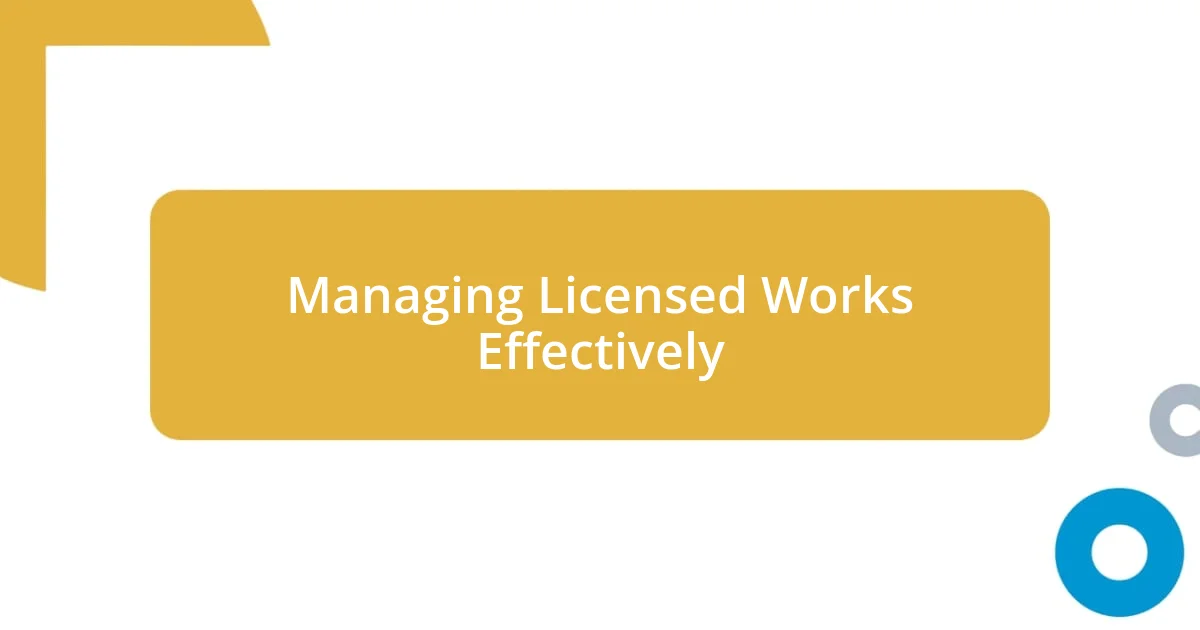Key takeaways:
- Understanding literary licensing is crucial for protecting authors’ rights and ensuring their works are treated respectfully during adaptations and distributions.
- Effective negotiation and clear communication are essential, as misunderstandings can lead to unfavorable agreements; documentation of discussions can help avoid disputes.
- Proactive management of licensed works, including setting performance indicators and maintaining clear communication, helps ensure the success and integrity of creative collaborations.

Understanding Literary Licensing
Literary licensing is essentially permission granted to use a creator’s work, and understanding this process can be crucial for any writer or publisher. I remember feeling overwhelmed the first time I encountered the need for a license; it was as if I had stumbled into a maze without a map. Have you ever found yourself in a similar situation, unsure of how to navigate the intricacies of copyright?
At its core, literary licensing protects the author’s rights while allowing others to adapt or distribute their work legally. I still recall my excitement when a small publisher approached me for rights to my short story. It felt exhilarating but also daunting, as I had to ensure that my creation was treated with the respect it deserved. It made me think about the importance of setting clear terms in any licensing agreement to safeguard an author’s intentions.
In the realm of literature, having a solid grasp on licensing not only empowers creators but also fosters a culture of respect and integrity. Have you ever worried whether your work might be used without your permission? It’s a valid concern. I believe that this understanding is instrumental in fostering a healthy ecosystem for creativity, where ideas can be shared and respected.

Identifying Your Literary Work
Identifying your literary work can sometimes feel like an introspective journey. When I first began writing, it took me a while to truly understand what defined my creations. For instance, was it just the story I wrote, or did my unique voice and perspective make it uniquely mine? I found clarity in these reflections, and I encourage you to do the same. Understanding what makes your work distinctive can empower you when navigating the licensing process.
To help pinpoint your literary work, consider these factors:
- Genre: What category does your work fit into—fiction, poetry, non-fiction, etc.?
- Theme: What core ideas or messages does your work convey?
- Voice: How would you describe your writing style? Is it humorous, serious, poetic?
- Target Audience: Who do you envision reading your work? Understanding your audience can shape how you license it.
- Length and Format: Is it a short story, novel, or an article? The format may influence your licensing approach.
Reflecting on these aspects can aid you in clearly defining what you have created, making the subsequent licensing steps smoother and more straightforward.

Researching Licensing Requirements
Researching licensing requirements is essential in understanding how to legally share your literary creations. I remember diving into the specifics of licensing when I was preparing to share my first novel, feeling like I was unearthing pieces of a puzzle. It struck me how various platforms and countries have different regulations—something I initially overlooked. And, trust me, navigating this maze without understanding the requirements can lead to costly mistakes.
To streamline your research, I found it helpful to create a checklist that outlines key aspects you need to look into: the type of license required, specific permissions related to your work, and any regional legalities. Each step I took felt like building a strong foundation, and I felt more confident as I learned what was necessary. I often ask creators to consider not only what’s required legally but also how they want to protect their artistic integrity. It’s about ensuring that your work is respected while also understanding that every right you give away might impact your creative freedom later on.
Comparing these requirements is also crucial. Sometimes, I find it beneficial to visualize the differences across various licenses and their implications. This practice of comparison helped me grasp not only the surface differences but also the underlying values each license represents. Are you ready to dive deeper into these distinctions? Let’s break it down together in a table for a clearer perspective.
| License Type | Description |
|---|---|
| Exclusive License | Gives the licensee sole rights to use the work, preventing the author from licensing it to others. |
| Non-exclusive License | Allows the author to grant the same rights to multiple licensees. |
| Collective License | Applicable for adaptations or compilations, where several authors’ works are used together. |

Preparing Your Work for Licensing
Preparing your literary work for licensing is a critical step that deserves careful consideration. When I first approached licensing, I remember feeling a mixture of excitement and anxiety. I needed to ensure that every element of my manuscript was polished, from the formatting to the acknowledgments. Have you reviewed your work thoroughly? I’ve learned that a clean, well-presented piece not only reflects professionalism but also shows respect for potential partners in the licensing process.
One practical tip I found helpful was to create a detailed summary of my literary work. By distilling my story into key themes and elements, I could easily convey the essence of my writing to interested parties. This summary became a key document that I could share, fostering more meaningful discussions. What about your work could captivate others? Think about that unique perspective or twist that sets your creation apart—it’s this insight that can spark interest.
Lastly, remember to gather all relevant materials. I found it useful to compile supporting documents, like reviews or listings of past publications if applicable. This not only boosts my credibility but also provides an enriching context for potential licensors. Are you ready to showcase your work in its best light? Taking this extra step can make a significant difference in how your literary creations are perceived in the licensing landscape.

Negotiating Licensing Agreements
Negotiating licensing agreements can feel like walking a tightrope; one misstep could tip the balance towards an unfavorable deal. I remember my first negotiation vividly—I was armed with knowledge but lacked confidence. The importance of clarity in communication struck me when the publisher had a different understanding of the rights being granted. It taught me to articulate my needs clearly and to ask questions if I sensed any ambiguity. Have you ever felt that what you meant didn’t match what was understood? It’s a common pitfall!
One critical aspect I learned was the art of compromise. In hindsight, I realize that being flexible can often lead to mutually beneficial outcomes. During a negotiation, I was adamant about retaining certain rights, but when I listened to the other party’s concerns, I found areas where we could meet halfway. This collaborative spirit enhanced the relationship—something I didn’t fully appreciate until later. Have you ever been surprised by how a small concession can foster goodwill? It certainly opened doors for future collaborations for me.
Additionally, I can’t stress enough the value of documenting every aspect of the negotiation. After I wrapped up a deal that involved several revisions, I learned the hard way about the dangers of relying on memory. I began taking detailed notes during meetings and followed up with emails outlining our discussions. This practice not only ensured everyone was on the same page but also served as a reference point in case disputes arose later. Trust me, investing the time to document these details will save you headaches down the road. What strategies do you think would work for you in keeping negotiations transparent?

Managing Licensed Works Effectively
Managing licensed works effectively requires a proactive mindset throughout the entire lifecycle of the agreement. I remember when I first began managing my licensed works; I approached it with trepidation. The realization that I needed to monitor how my work was being used under the licensing agreement hit me hard. It taught me that staying engaged with the licensee is crucial. Are you keeping communication lines open? Regular check-ins can help prevent misunderstandings and ensure that your expectations align with what’s being done.
One technique that really made a difference for me was setting clear performance indicators for the licensing agreement. For instance, I established specific metrics to evaluate the success of a book adaptation when I licensed one of my novels. By defining what success looks like upfront, I could measure the impact and make informed decisions about any future collaborations. Have you considered how you’d measure the value of your licensed work? This approach keeps everyone accountable and helps maintain a healthy working relationship.
Additionally, I learned that documenting everything is essential to managing licensed works. After overlooking an important clause in a contract, I faced challenges that could have been easily avoided. Now, I maintain a detailed ledger of all licensing agreements, including key dates, financials, and other relevant information. This organized system not only keeps me informed but also allows for smooth renewals and modifications. Imagine how streamlined your process might become with a little organization—what steps could you take to ensure you’re not caught off guard?

Renewing and Ending Licenses
Renewing a license can sometimes feel like a tightrope walk of its own. I’ve encountered moments when a renewal negotiation felt more like a chess game, with each party calculating their next move. Just last year, I faced a situation where I had to advocate for updated terms that reflected the changing market landscape. I remember my exhilaration when the licensee finally agreed to a more favorable royalty structure. Have you experienced the thrill of a successfully renegotiated deal? It’s one of those moments that validates all the effort you’ve put into the relationship.
When it comes to ending licenses, I’ve learned that clear communication is essential. There was a time when I neglected to communicate my intent to conclude a licensing agreement, thinking a quiet withdrawal would suffice. It was a miscalculation that caught everyone off guard, leading to confusion and unnecessary friction. Since that experience, I prioritize a complete and respectful dialogue, outlining reasons for the termination well in advance. How do you approach ending agreements? I believe taking the time to convey your intentions can help maintain professional relationships for any future collaborations.
I’ve also realized the importance of timing in both renewing and ending licenses. If I sense that a project is nearing its conclusion, I start discussions early. One time, I initiated renewal talks two months before the expiration, which felt proactive and reassuring. It allowed both parties to assess the value of the ongoing collaboration without the pressure of deadlines. Have you found that giving yourself plenty of time to negotiate leads to better outcomes? Trust me, it often makes all the difference when you’re navigating the twists and turns of licensing agreements.












